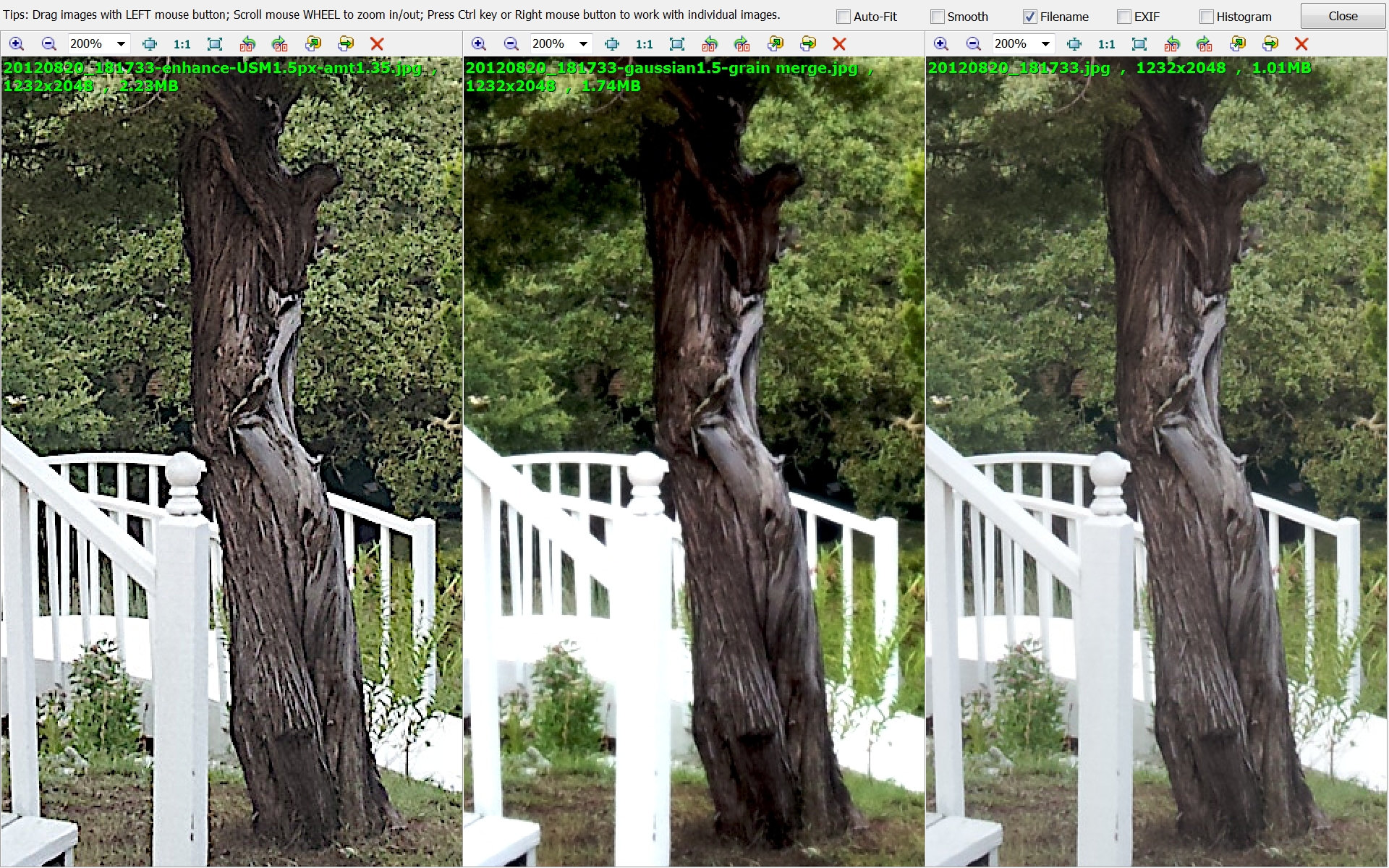I've never truly understood why people sharpen with something called "unsharp masking", duh.
Today, I read that it started in the film era, double-duh:
https://en.wikipedia.org/wiki/Unshar...nsharp_masking
So now that I have an app that does layers, I just had to play:
App's USM versus my layers "USM" versus original:
It occurs to me that many of the fancy options available in modern computational photography are based on simpler techniques of yesteryear, eh?
It does seem that my choice of Gaussian radius, amount and threshold in the "unsharp" layer were a bit off, ho hum.
Results 1 to 10 of 10
Thread: Playing with USM basics
-
15th December 2021, 08:21 PM #1

- Join Date
- Feb 2012
- Location
- Texas
- Posts
- 6,956
- Real Name
- Ted
Playing with USM basics
Last edited by xpatUSA; 15th December 2021 at 08:42 PM.
-
15th December 2021, 08:29 PM #2

- Join Date
- Nov 2010
- Location
- South Island, New Zealand
- Posts
- 651
- Real Name
- Ken
Re: Playing with USM basics
Interesting that the left image is twice the size of the right
-
15th December 2021, 08:48 PM #3

- Join Date
- Feb 2012
- Location
- Texas
- Posts
- 6,956
- Real Name
- Ted
Re: Playing with USM basics
Last edited by xpatUSA; 15th December 2021 at 08:49 PM. Reason: already knew
-
15th December 2021, 09:13 PM #4
Re: Playing with USM basics
I learned about using USM 15 years ago when i started digital photography.
Never seen the need to use anything else.
-
15th December 2021, 09:31 PM #5

- Join Date
- Feb 2012
- Location
- Texas
- Posts
- 6,956
- Real Name
- Ted
-
15th December 2021, 10:59 PM #6
-
15th December 2021, 11:45 PM #7
Re: Playing with USM basics
Ted as the late Peter Allen (aka The Boy From Oz) used to sing - Everything Old is New Again.
Wavelet sharpening basically involves making adjustments in the (spatial) frequency domain, much like an audio graphic equaliser. Many years ago in the mid eighties I was working on long distance analogue television transmission links and had a problem with slow rise time of the video or smearing as it was called I think. This is akin to poor Edge Spread function in digital imaging. My problem was solved using a simple L-C filter which adjusted the frequency response of the signal. You had to be careful not to overdo it though, otherwise you would get overshoot and ringing, cf halos in digital images from over-sharpening!
Dave
-
16th December 2021, 12:49 AM #8

- Join Date
- Feb 2012
- Location
- Texas
- Posts
- 6,956
- Real Name
- Ted
Re: Playing with USM basics
That's the trouble with Oz, Dave, all them long distances.

Never had that trouble in England, LOL.
I remember similar stuff when designing a gas turbine speed control - was my first encounter with the work of a gentleman by the name of Nyquist - in that case to do with closed-loop control stability ...Last edited by xpatUSA; 16th December 2021 at 06:53 PM.
-
16th December 2021, 06:37 PM #9

- Join Date
- Jan 2009
- Location
- South Devon, UK
- Posts
- 14,624
Re: Playing with USM basics
Like many photo 'enhancements' sharpening, whichever method is used, needs careful application. Just because there are higher adjustment levels available on a variable slider doesn't mean those values should be regularly applied. Subtle use of slight adjustments is best.
And no amount of sharpening during editing is going to cure an out of focus shot.
-
18th December 2021, 03:20 AM #10
Re: Playing with USM basics
Everyone has their own "secret sauce" when it comes to sharpening. I take the traditional three-step sharpening approach in my work. I use the default value for input sharpening in most cases, although I do over-ride it when large parts of the scene are going to require softening / blurring in the final output (why sharpen globally when you have to undo it all later).
I often, especially in closeup portraits, use in-process sharpening on the irises, lips, eye lashes and eyebrows.
When I output sharpen I will often mask out parts of the image; high frequency areas that can start looking "cruchy", skin that has been softened, clouds, water. I don't sharpen blacks / dark shadow areas or whites / bright highlights as neither look right when sharpened (easy to do with Photoshop's blend if tool).
USM is generally my go too sharpening tool.

 Helpful Posts:
Helpful Posts: 

 Reply With Quote
Reply With Quote


